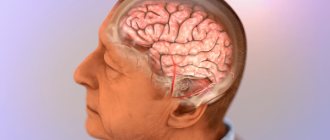Alzheimer's disease
is a chronic, progressive disease that impairs memory, thinking and movement. Some studies show that a person is at increased risk of developing Alzheimer's disease if they have a relative with the disorder.
Alzheimer's disease
is the most common cause of dementia and can seriously affect a person's ability to think, make judgments and carry out everyday tasks. Doctors have known about Alzheimer's disease for years, but many aspects of the condition and possible treatments remain unknown. The causes of Alzheimer's disease are unclear. Modern research shows that many factors can contribute to the development of Alzheimer's disease, one of which is genetics or heredity.
Is Alzheimer's disease inherited?
Scientists describe genetic risks for Alzheimer's disease in terms of two factors: risk genes and determinant genes.
When a person has risk genes, it means they are more likely to develop the disease. For example, a woman with the BRCA1 and BRCA2 genes has a higher risk of developing breast cancer.
Determined genes can directly cause the development of the disease.
Scientists have discovered several risk and deterministic genes for Alzheimer's disease.
Treatment prognosis
In general, the prognosis for Alzheimer's disease is negative. After diagnosis, the average life expectancy does not exceed 7 years. The 14-year survival rate does not exceed 3%.
But this does not mean that nothing can be done in this situation. The International Clinic Medica24 uses methods of drug and palliative therapy that help prolong a person’s life, slow down the development of dementia, improve mental abilities, maintain or improve the quality of life.
The material was prepared by Natalya Yuryevna, a neurologist at the International Clinic Medica24, Candidate of Medical Sciences Lasch.
Risk genes
Several genes pose a risk for developing Alzheimer's disease. The gene with the most significant association with Alzheimer's disease is the apolipoprotein E-e4 (APOE-e4) gene. About 20-25% of people with this gene may suffer from Alzheimer's disease. A person who inherited the APOE-e4 gene from both parents has a higher risk of developing Alzheimer's disease than a person who inherited the gene from only one. Having the gene may mean that a person exhibits symptoms at an earlier age and is diagnosed earlier. Other genes may influence late-stage Alzheimer's disease and its progression. Scientists need to do more research to find out how these genes increase the risk of developing Alzheimer's disease.
Some of these genes regulate certain factors in the brain, such as inflammation and the way nerve cells communicate. While everyone inherits the APOE gene in some form, the APOE-e3 and APOE-e2 genes have no connection with Alzheimer's disease. APOE-e2 may even have a protective effect on the brain against the disease.
Determined genes
Researchers have identified three specific deterministic genes that may cause Alzheimer's disease:
- amyloid beta precursor (APP)
- presenilin-1 (PS-1)
- presenilin-2 (PS-2)
These genes are responsible for excessive accumulation of amyloid beta peptide, a toxic protein that accumulates in the brain and causes nerve cell damage that is characteristic of Alzheimer's disease. However, not all people with early-onset Alzheimer's disease have these genes. A person with these genes who develops Alzheimer's disease has a rare type known as familial Alzheimer's disorder. Familial Alzheimer's disease accounts for less than 5% of all cases worldwide. Alzheimer's disease, caused by genetic determinants, usually occurs before age 65. Sometimes it can develop in people aged 40-50 years.
Description of the disease
Ancient Greek and Roman doctors wrote about the weakening of reason in old age. But for the first time this disease was noticed by Alois Alzheimer, who in 1901 began monitoring Augusta Deter. She was 50 years old and her dementia was getting worse every day. After the death of the patient, the doctor published materials containing an analysis of the disease that was later named after him.
Initially, Alzheimer's disease was the name given to dementia that develops in young patients, while older people were classified as people who develop senile dementia. Today, the diagnosis of Alzheimer's type dementia is made in the presence of characteristic symptoms that develop in a certain way and are accompanied by typical signs of neuropathology. The patient's age does not matter.
Alzheimer's disease is usually divided into four main stages, at each of which there is a progression of dysfunction:
- Predementia. Signs characteristic of this stage of the disease are often confused with the body's reaction to stressful situations. Minor cognitive impairments begin to appear approximately 5-7 years before a definitive diagnosis is made. Abnormalities can only be identified through detailed neurocognitive testing. The first problems with memory appear, the patient experiences difficulties in learning new material. The ability to plan is also lost, the first problems with concentration and abstract thinking appear, but they are little noticeable at this stage of the development of the disease. Apathy often appears, which is considered the most consistent sign of dementia at all its stages.
- Early dementia is more often characterized by impairments in speech and basic executive functions. Memory disorders recede into the background for some time. At this stage, a person is still able to operate with simple concepts in the process of verbal communication, performs everyday tasks without outside help, and perfectly remembers events from the past or information that was once memorized. But from the side of the patient it may seem awkward - this is due to the presence of some coordination problems and the loss of the ability to plan the movements of her body.
- Moderate dementia. As the disease progresses, it leads to a gradual loss of the ability to function independently. Disorders become obvious, the patient loses access to his own vocabulary. He pronounces the wrong words, inserting them into his speech instead of forgotten ones. Coordination is so impaired that the patient loses the ability to perform most daily tasks. At this stage, all types of memory noticeably deteriorate; the person no longer recognizes family members and other close people.
- Severe dementia is the last stage of the disease. A person at this stage is no longer able to cope without the help of other people. Speech communication is reduced to the pronunciation of individual phrases or words, and gradually this ability is lost. Body weight decreases sharply, the patient is in a state of severe apathy.
The result of Alzheimer's type dementia is the death of the patient. However, the real cause of death is often third-party diseases and pathologies, such as pneumonia or pressure ulcers.
Gene influence on other types of dementia
Some types of dementia are associated with other genetic defects.
Huntington's disease
, for example, is caused by a change in chromosome 4, which can manifest as progressive dementia. Huntington's disease is a dominant genetic disorder. This means that if one parent has the disease, they can pass the gene on to their offspring and they will develop the disease. Symptoms of Huntington's disease usually do not appear until age 30 to 50. This can make it difficult for doctors to predict and diagnose before a person has children and passes on the gene.
Researchers believe that Lewy body dementia, or Parkinson's disease dementia, may also have a genetic component. However, they believe that other factors not related to genetics may also play a role in the development of these conditions.
How can Alzheimer's be inherited?
Based on the results of numerous studies of family members of patients and further observations of the subjects, two main types of inheritance of the pathology were identified: the autosomal dominant family form and other forms.
Family forms
The cause of the disease is a rare type of gene mutation that is inherited from generation to generation. In such families, the disease is detected in 50% of cases. The first symptoms appear early (before age 55).
To confirm the family form, they resort to genetic analysis of the DNA of the patient and relatives, and create a family tree indicating all known cases of dementia in the family. With such forms of the disease, people with this pathology are found in every generation.
Alzheimer's disease with other mode of inheritance
In most cases, it is caused not by one hereditary mutation, but by multiple changes in the genome that are not inherited. The etiology of this type of Alzheimer's disease has not been studied, and many theories have been questioned.
External factors, such as ecology, nutrition, social influence, and working conditions, also play a significant role in the development of the disease.
Important! In the development of Alzheimer's, genes do not play the most important role; a person's lifestyle, physical activity and nutrition largely determine the rate of development of pathological processes in the central nervous system.
With such forms of the disease, no pattern is observed in the family tree. If we analyze it, then cases of dementia will occur in the form of isolated cases and not in every generation.
Risk factors for developing Alzheimer's disease
Researchers have identified several risk factors for developing Alzheimer's disease. These include:
Age
: The most significant risk factor for developing Alzheimer's disease is age. People over 65 are more likely to develop Alzheimer's disease than younger people. By age 85, 1 in 3 people have this condition.
Family history
: Having a close relative with Alzheimer's disease increases your risk of developing it.
Head injury
: People with a history of severe head trauma, such as from a car accident or contact sports, are at higher risk of developing Alzheimer's disease.
Heart Health
: Cardiovascular health problems may increase your chance of developing Alzheimer's disease. Examples include high blood pressure, ischemic stroke, diabetes, heart disease and high cholesterol. The conditions listed above can damage blood vessels in the brain, which affects the risk of developing Alzheimer's disease.
Genetic predisposition to developing dementia
25% of the world's population in the age group 55 years and older have a family history of dementia. In most cases, familial cases of this pathology arise due to the presence of multiple genetic defects, which together significantly increase the risk of developing dementia. A small proportion of families among the general population have monogenic forms of dementia with early manifestations of the disease, which are caused by a mutation in one of the dementia genes.
In this review, the authors focused on the results and methods of genetic diagnosis of Alzheimer's disease (APP, PSEN1 and PSEN2 genes) with consideration of practical aspects of medical genetic counseling.
Introduction
When a family member is diagnosed with dementia, a clinician may often hear the question, “My mom has dementia. Perhaps I will develop it too; can I check and prevent this?
It should be noted that an aggravated history of dementia in relatives does not necessarily mean the presence of a monogenic form of the disease. Mendelian forms of dementia are known to be extremely rare. For example, only 500 families with Mendelian forms of Alzheimer's disease have been registered. Thus, most people with a family history of the disease do not need molecular genetic testing and can rest easy.
How can we identify the small number of families at increased risk of developing dementia?
Mendelian form of the disease and multifactorial diseases
Each family is influenced by both environmental and genetic factors, so family diseases are not always hereditary. The most prominent example of dementia caused by environmental factors is kuru. This pathology is an infectious prion disease first reported in 1950 on the Papuan Islands of New Guinea, where relatives consumed food for the deceased in funeral rituals. At first, everyone believed that this disease was of a genetic nature due to its familial nature, but the results of experimental work showed that it was, in fact, a transmissible spongiform encephalopathy.
However, in the overwhelming majority, the risk factors we know for developing dementia are of a genetic nature.
Genetic factors can contribute to the development of familial dementia in two ways: leading to Mendelian forms of the disease (monogenic) or as a contributing factor in multifactorial (polygenic) diseases (Fig. 1).
Figure 1. Comparison of the pathogenesis of monogenic and polygenic (multifactorial) diseases.
Clinical implications of Mendelian forms of dementia
Monogenic forms of dementia with identified culprit genes obey autosomal dominant principles of inheritance and have high penetrance when there is a high incidence rate in subsequent generations. In this case, genetic counseling is very useful. Despite the presence in the family tree of individuals who are carriers of the mutation, but who have not currently shown signs of the disease, these people develop dementia in 95% or more of cases. The exact risk of developing the disease depends on the age of manifestation of dementia in the family and the penetrance of the gene, which is determined by the possibility of developing the disease phenotype in a person with a mutation in the gene. It is important to note that individuals who do not carry mutations in the genome have the same risk of developing dementia as in the general population.
Principles of genetic research in dementia
Considering the need for genetic testing involves two steps. The first step is a detailed analysis of the family history (presence of the disease in relatives in several generations) with differentiation between the monogenic type of inheritance and multifactorial forms of the disease. In this aspect, genetic analysis is recommended for families with an autosomal dominant type of inheritance of the disease. The second step towards the right decision is a detailed analysis of the disease phenotype in order to conduct a genetic test adequate to the needs. For example, a history of mental disorders as an integral indicator of the disease phenotype is characteristic of frontotemporal dementia. A clear account of the age of manifestation of the disease can serve as an auxiliary factor in determining the likelihood of developing Alzheimer's disease in families whose members suffered from this pathology. It is best to start genetic research with a family member who already has signs of dementia.
Genetic aspect of Alzheimer's disease
Clinically, the typical form of Alzheimer's disease is characterized by a gradual onset and rapid progression to memory impairment and cognitive dysfunction (according to the 1984 criteria of the National Institute of Neurological and Communicative Disorders and Stroke–Alzheimer's Disease and Related Disorders Association [NINCDS-ADRDA]). These diagnostic criteria have been revised to identify forms of the disease without memory impairment (with language, visuospatial dysfunction) and to determine the role of biomarkers in diagnosis (2011 criteria of the National Institute on Aging–Alzheimer's Association [NIA-AA]).
Monogenic forms of Alzheimer's disease are extremely rare: over 35 million people in the world suffer from this pathology, but genetic mutations have been identified in 500 families. Key elements in the disease history that help differentiate Mendelian inheritance from polygenic inheritance are: inheritance of the disease across generations and early age of disease manifestation (Table 1). Family members meeting these parameters carry a pathogenetic mutation in one of the genes identified for the disease. For example, Raux and colleagues, studying a cohort of 65 families with early manifestations of the disease (under 60 years of age) and the presence of the disease in three generations, identified: in 86% of cases, a mutation in the gene responsible for the disease (78% in the form of a change in the nucleotide sequence, 8% - in the form of pathological gene duplication). However, families meeting these criteria are very rare: the prevalence in the 41-60 age group is about 5 per 100,000 people.
Table 1. Probability of having a pathogenetic mutation in one of the known genes responsible for Alzheimer's disease
| Age of onset of symptoms | Probability of having a mutation |
| The presence of the disease in three generations | 86% |
| Presence of the disease in 2 or more 1st degree relatives | 68% |
| Presence of the disease in 2 or more 1st degree relatives | 15% |
| Presence of the disease in 2 or more 1st degree relatives | over 65 years old |
This group of families with autosomal dominant inheritance of the pathology at the onset of the disease has the same clinical picture as other forms of the disease, however, the development of myoclonus in the early stages of the disease can be a diagnostic marker of a monogenic disease.
There are three known causative genes for Alzheimer's disease: APP, PSEN1 and PSEN2. It should be noted that the first of these, the APP gene on chromosome 21, was discovered in 1987 in individuals with trisomy 21 (Down syndrome), who develop dementia with a similar histopathological picture. However, no families with an APP mutation were reported until 1991. By that time, it was established that the main histopathological features of Alzheimer's disease are the presence of amyloid plaques and neurofibrillary tangles. Duplication of APP leads to the formation of beta-amyloid, the main component of amyloid plaques. This finding formed the basis of the amyloid hypothesis, which suggests that the production and degradation of beta-amyloid are central to the pathogenesis of not only the Mendelian form of the disease, but also the multifactorial disease that has developed in the general population.
Subsequently, two additional culprit genes were identified: PSEN1 on chromosome 14 and PSEN2 on chromosome 1. In both cases, the mutations led to overproduction of beta-amyloid or, in some cases, to a change in the ratio of beta-amyloid isoforms 1-42 to beta-amyloid1 -40 (Fig. 1).
Figure 1. Amyloid hypothesis and pathogenesis of Alzheimer's disease.
This is how the amyloid hypothesis was formed, which is the dominant paradigm in the study of this disease. Although the pathogenesis of the disease in the general population is probably more complex and multifactorial.
As noted earlier, 86% of families with early onset dementia (before the age of 60 years) in three or more generations have mutations in the APP, PSEN1 or PSEN2 genes. PSEN1 mutations are the most common cause, occurring in 60% of families with the Mendelian form of the disease. About 15% of families have a mutation in the form of a change in the nucleotide sequence of APP, and in 8% of cases APP duplication occurs. PSEN2 mutations are quite rare: they were found in only 22 families.
Thus, if necessary, screening for the presence of a PSEN1 mutation is performed first. There are also clinical clues for prioritizing genetic testing. Thus, the presence of Alzheimer's disease and spastic paraparesis is more typical in the presence of a PSEN1 mutation. While APP mutation often leads to cerebral amyloid angiopathy with the development of cerebral hemorrhages.
Practical aspects of medical genetic counseling
Genetic counseling is usually performed in individuals with established disease and for prognosis purposes. In both cases this procedure is useful. Of course, genetic testing in persons with a developed disease does not affect the clinical management of the patient, but can serve as a good assistant in making a diagnosis when it is not so obvious, and also, in the case of identifying a monogenic disease, be a reason for consulting all family members.
It is important that a face-to-face consultation with a geneticist is necessary to clarify all the “dots and i’s” when it comes to conducting genetic tests to determine the prognosis for the development of the disease in the future. And the main thing in this aspect is the understanding that there are no preventive measures for treating this pathology. In such cases, family members want genetic testing for three reasons: memory function, future life planning, and fertility planning. It is noted that if positive results are obtained, there is an increased risk of suicide, so it is not recommended to conduct examinations in patients with psychological and psychiatric problems.
Conclusion
Fortunately, monogenic forms of dementia are rare. Relatives of patients who develop the disease have a lifetime risk of developing dementia of about 20%, compared with 10% in the general population. However, a small cohort of families with autosomal dominant forms of inheritance have a mutation in one of the culprit genes. Each child of a patient with a monogenic disease has a 50% chance of having the same mutation and, if present, faces a 95% risk of developing the disease during his or her lifetime. About 50% of relatives in such families, after detailed consultation with a geneticist and attending physician, refuse genetic testing to identify the culprit genes for a disease that has not yet developed.
Source: Clement T Loy, Prof Peter R Schofield, Anne M Turner. Genetics of dementia. The Lancet. Published online August 6, 2013 https://dx.doi.org/10.1016/S0140-6736(13)60630-3
Early signs of Alzheimer's disease
Alzheimer's disease is usually accompanied by a gradual loss of memory and brain function. Early symptoms may include periods of forgetfulness or memory loss. Over time, a person may experience confusion or disorientation in familiar environments, including at home.
Other symptoms may include:
- changes in mood or personality
- confusion about time and place
- difficulty with routine tasks such as doing laundry or cooking
- difficulty recognizing objects
- difficulty recognizing people
The aging process can naturally deteriorate a person's memory, but Alzheimer's disease leads to longer periods of forgetfulness.
Over time, a person with Alzheimer's disease may need more and more assistance with activities of daily living, such as brushing teeth, getting dressed, and eating. They may experience agitation, restlessness, personality disorders and speech problems. The life expectancy of a person with Alzheimer's disease is usually 8 to 10 years after the first symptoms of the disease appear.
Because people with advanced Alzheimer's disease are unable to care for themselves or may not understand the importance of food, common causes of death include malnutrition, malnutrition, or pneumonia.
Methods of transmission of the disease
Inheritance of pathology in the first scenario occurs rarely, but in this case the disease develops with 100% probability. Signs usually appear before old age. Persons with this form of predisposition are recommended to undergo special tests at a young age, get advice from a geneticist, and begin intensive prevention.
Heredity according to the first genotype comes in several varieties:
- 1st chromosome - only a few dozen families are at risk. The clinical picture develops quite late;
- 14th chromosome - 400 families with a mutation of this gene are officially registered on the planet. The peculiarity is that against such a background, senile dementia develops very early. Cases of diagnosis at 30 years of age have been reported;
- Chromosome 21 - damage to the gene leads to the development of a pathology called familial Alzheimer's disease. Approximately a thousand families around the world have been diagnosed. The first obvious signs of degenerative changes in the brain are detected at 30-40 years of age.
Chromosome 21 - damage to the gene leads to the development of a pathology, which is called a familial disease, the diagnosis has been made to approximately a thousand families around the world.
Inheritance by the second genotype is diagnosed much more often. It can be triggered by a number of genes, the most well studied of which is apolipoprotein. Its mutation can be detected using special tests, but this approach is still used quite rarely. This type of heredity becomes not the cause of the disease itself, but a predisposition to changes in the structure of the nervous tissue.
When to see a doctor
Seeking medical help for a person who has these symptoms is vital. Your doctor can rule out other conditions that may cause dementia, such as a urinary tract infection or a brain tumor.
Family members should make a list of all medications the symptomatic person is currently taking. Your doctor can review the list to make sure your dementia symptoms are not side effects of medications.
Identifying noticeable symptoms and their progression can help the doctor identify potential patterns. Although genetic testing is available, doctors generally do not recommend it. Having the genes does not necessarily mean a person will have the condition, and testing may cause unnecessary anxiety and fear. However, a person with a family history of early Alzheimer's disease may wish to undergo genetic testing. Most doctors recommend meeting with a genetic counselor ahead of time to discuss the pros and cons of genetic testing and how they might interpret the results.
Sometimes a doctor may recommend genetic testing when a person exhibits early symptoms of Alzheimer's disease, as this may dictate possible treatments.









